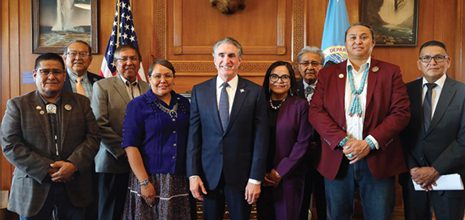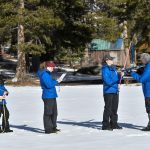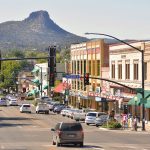- Navajo Nation urges swift action on long-delayed Northeastern Arizona Indian Water Rights Settlement.
- Leaders say one-third of Navajo residents still lack safe drinking water.
- Federal land decisions have stalled key water infrastructure projects.
- Over 500 uranium-contaminated sites remain unremediated.
- Broader tribal concerns include grazing permits and land use authority.
Friday, April 18, 2025— In a high-stakes meeting with U.S. Interior Secretary Doug Burgum on April 14, members of the Navajo Nation’s Resources and Development Committee (RDC) pressed for urgent federal action on water rights, land use, and environmental cleanup. Central to the discussion was the Northeastern Arizona Indian Water Rights Settlement Act, a long-anticipated agreement that could finally bring water security to thousands of Navajo households.
Speaker Crystalyne Curley led the delegation, emphasizing the life-or-death urgency of the issue. “We are here to elevate the needs of our communities that include basic needs like clean drinking water, access to infrastructure, and fair treatment of our landowners,” said Curley . “We are seeking partnership and action, not more delays.”
. “We are seeking partnership and action, not more delays.”
One-Third Without Safe Water.
Despite contributing to the growth of cities like Los Angeles and Phoenix, many Navajo communities remain without reliable access to water. “We helped build major cities across the Southwest… but now we’re left at the end of the water line,” said Speaker Curley . She added that about one-third of Navajo residents still haul water long distances for everyday use.
. She added that about one-third of Navajo residents still haul water long distances for everyday use.
RDC Chair Brenda Jesus noted that the Nation has long engaged in good-faith negotiations with the seven Colorado River Basin states. “Now is the time to finalize a settlement guaranteeing Navajo water rights,” she said . Delegate Otto Tso stressed the immediacy, warning, “Some of our families may never see running water in their lifetimes unless something changes now.”
. Delegate Otto Tso stressed the immediacy, warning, “Some of our families may never see running water in their lifetimes unless something changes now.”
Chaco Canyon Withdrawal Sparks Frustration.
The meeting also addressed Public Land Order No. 7923, which created a buffer zone around Chaco Canyon. Delegates said the order , made without consulting Navajo landowners, has frozen development and delayed critical infrastructure.
, made without consulting Navajo landowners, has frozen development and delayed critical infrastructure.
Delegate Danny Simpson voiced the economic harm. “The buffer zone undermines the economic self-sufficiency of over 4,000 Navajo allottees who own both surface and subsurface rights,” he said. “These are families who have lived and worked on these lands for generations.”
Chair Jesus added, “Our homes, our roads, and our ability to thrive are now locked behind a decision we were not included in.”
Uranium Cleanup Still on Hold.
Another priority was the cleanup of over 500 abandoned uranium mines on Navajo land. Delegate Casey Allen Johnson shared a personal tragedy to underscore the urgency. “There are 111 abandoned uranium mines in my region alone. I lost both of my parents to cancer that we believe was caused by uranium exposure,” he said.
Despite decades of studies, actual remediation remains elusive. Council members demanded the transition from planning to implementation.
Secretary Burgum acknowledged these concerns and pledged more robust interagency coordination, stating, “We are committed to being partners in this effort and ensuring the Interior Department takes meaningful steps forward.”
Broader Jurisdictional Issues.
In addition to water and environmental concerns, the committee raised issues surrounding federal oversight of grazing permits and livestock management. Members urged consistent federal engagement that respects treaty obligations and honors tribal sovereignty.
The meeting concluded with a unified message from the Navajo Nation: sustained consultation, infrastructure investment, and swift, meaningful action are long overdue.
For updates, visit navajonationcouncil.org .
.
~~~
Image via the Navajo Nation Council press release . “Members of the Resources and Development Committee were joined by Speaker Crystalyne Curley, Eastern Navajo Agency allottees, and Navajo EPA representatives as they met with U.S. Secretary of Interior Doug Burgum (center).”
. “Members of the Resources and Development Committee were joined by Speaker Crystalyne Curley, Eastern Navajo Agency allottees, and Navajo EPA representatives as they met with U.S. Secretary of Interior Doug Burgum (center).”






Leave a Reply